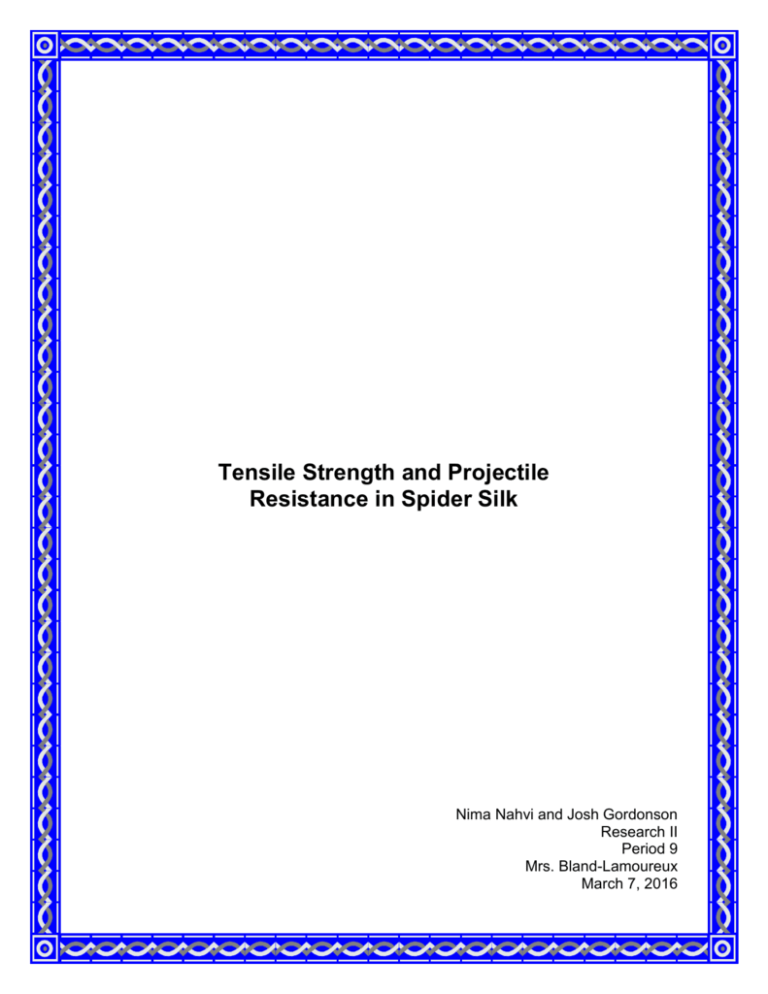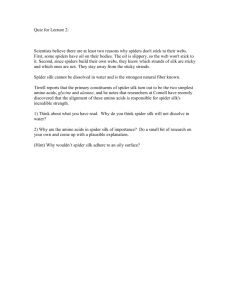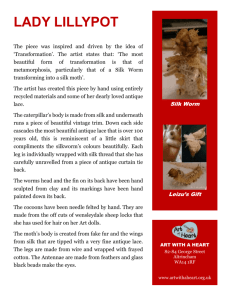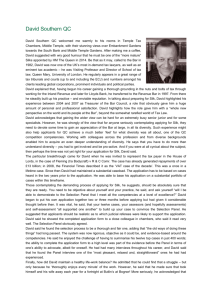For hundreds of years people have been trying to farm
advertisement

Tensile Strength and Projectile Resistance in Spider Silk Nima Nahvi and Josh Gordonson Research II Period 9 Mrs. Bland-Lamoureux March 7, 2016 1 Spider silk is known to be one of the strongest, sturdiest, and most elastic substances there are on this planet. Compared to steel on " ‘a per weight ratio’ it is up to five times stronger, and three times tougher than aramid fibre," as said so by Nexia Biotechnologies Incorporation and the U.S. Army Soldier Biological Chemical Command (SBCCOM), in their article "Man Made Spider Silks." Other than its strength and toughness, spider silk is light and biodegradable, not to mention that it can bend 2550% its durability before it breaks. Steel can only bend up to 8% and Nylon only 20% before it breaks. Spider silk otherwise called BioSteel by the Nexia Inc. can be used to create many advances in the fields of medical, military and industrial performance fiber markets. The individual miniscule strands that spiders use in weaving their webs are so strong that they can stop a bee going 20 mph dead in its tracks without breaking. If one tiny strand can do that to a bee, thousands or millions of strands spun together should stop a bullet. In addition, the new methods of clothing for war could also be used at home. Knowing that spider silk is lighter and more flexible than many materials, new clothing can be fashioned Figure 1: Water droplets forming around the waterproof spider silk (Borchardt) out of it, ones that won’t rip as easily and protect bodies much more efficiently from harsh conditions such as rain. For hundreds of years people have been trying to farm spider silk, however, there are two problems with this. One is that the spiders have to be spaced far apart, so as to prevent them from eating one another, the other being that the silk hardens 2 when it first comes in contact with air, therefore making it difficult to work with. In 1709 the French government asked Rene-Antoine Ferchault de Reaumur to find uses for spider silk such as clothing. He then collected spider silk from egg sacks and tried to create gloves and stockings, after some time he gave up because of the immense amount of material it took to make only one pair of gloves (Lewis 1). Later on in the eighteenth century, another Frenchman named Bon de Saint-Hilaire attempted to farm spiders, but found out that because they eat each other, it is not efficient to do. In 1803 Daniel Rolt developed a silk-extracting machine that looked like a spool of thread on an engine (Lewis 1). After attaching the silk to the spool, the engine was turned on and the silk was extracted from the spider. Supposedly it could wind “18,000 feet of silk from two dozen spiders in two hours.” (Lewis 1) Between 1866 and 1873 Burt G. Wilder created an apparatus that immobilized the spider and held it in place for manual harvesting. Supposedly he had pulled out “150 yards from the particularly cooperative arachnid, then calculated that it would take 5000 animals to retrieve enough material to make one dress.” (Lewis 1) Because spider silk is so thin, it was used for the crosshairs in rifle scopes, microscopes, and other precision instruments. Ancient civilizations figured out ways to use spider webs. For instance, the Greeks used silk to help heal wounds, Australian aboriginals used the silk as fishing line, and the natives in New Guinea make bags, head gear, and fishing nets from Figure 2: Fibroin is being squeezed out of the tubes (Nieuwenhuys 1) the silk (Lewis 1). Today, scientists are trying to further 3 understand the exact chemical structure of spider silk so that they can replicate spider silk in large quantities. Some possibilities with spider silk are to create artificial tendons and ligaments, parachute cords bullet proof vests, or even a building material made out of silk (Lewis 2). There are two ways to synthesize the spider silk, one way is to put the silk together, piece by piece, on a high tech machine and the other way is to cut out the specific gene in spider cells that makes the silk and use recombinant DNA techniques to make bacteria produce the silk. Unfortunately, scientists do not know enough about the chemical structure of spider silk to construct it, so Randy Lewis has used spider DNA to create the liquid proteins in bacteria. After the proteins are extracted from the bacteria and placed in methanol, the Figure 3: The Fibroin all wrapped up (microscope) (Electron Microscope) silk is formed. Spider silk has been reported to be composed of two proteins, spidroin 1 and spidroin 2 (Lewis 2). Together these two proteins from a fiber called fibroin, when fibroin is twisted together, it becomes spider silk. At first, separate fibers of fibroin are 4 Figure 4: Silk Fibroin (Garrel) squeezed out of small tubes located on the spinners. After this, the spinners weave the fibers together to create the spider silk. For the most part, these two proteins only differ in the amount of tyrosine and proline. Since the amino acid sequence repeats so much, it is determined that the silk is a highly ordered structure. Most of spidroin 1 and spidroin 2 is composed of alanine and glycine. The alanine is grouped in sections of 5-10 repeating amino acids, most of the alanine is less organized and holds regions of highly organized beta sheets and amorphous background sheets together (Lewis 2). The rest of the alanine is located in the beta sheets along with lots of glycine. Because the spider silk is Figure 5: The sequence of a certian type of spider silk (Oroudjev and Soares and Arcdiacon amd Thompson and Fossey and Hansma) arranged this way, the silk has massive amounts of tensile strength. Some other amino acids in the silk are glutamine, serine, leucine, valine, proline, tyrosine and arginine. Because alanine and glycine are the two smallest amino acids, and do not have any side-groups, it would make sense that they are in the spider silk (Lewis 2). Due to the lack of side groups, the two amino acids can pack together more tightly and form a more organized crystalline structure faster and easier (Lewis 2). 5 According to George E. Goodfellow of Tombstone, Arizona a man that was shot for six feet away in the left breast was protected by a silk handkerchief placed in his pocket. After examining the wound, the bullet was found in a fold in the silk with two layers of silk surrounding it. After several subsequent tests, it was found that the bullet would normally go right through the body (Harp 2). Therefore, if a soldier were to wear several layers of silk under or over their clothing, there would be a lower chance of fatal wounds. By creating cloth or patches of layered spider silk and testing their tensile strength, the most effective type of spider silk could be determined and then tested using a projectile traveling at a fixed speed. In the future, spider silk, artificial or not, will be used in military and commercial situations. If possible, synthetic spider silk will be mass produced and sold to large manufacturers that would spin or weave the silk into useful products such as parachute cords or body amour. The use of spider silk, most likely will revolutionize the military and civilian aspects of everyday life. 6 Works Cited Borchardt, John K. Soon, spider-silk togs and mussel glue? Soon, spider-silk togs and mussel glue?. August 26, 2004. Online. October 27, 2005. <http://www.christian sciencemonitor.com/2004/0826/p13s01-stgn.html> Electron Microscope Lab. Online. 10/17/05 Internet.<http://biology.berkeley.edu/ EML/backgrounds.html>. Greenburg, J.C.. Spider Feet. Online. 10/17/05 Internet. <http://www.andrewlost.com /spider_feet_question_k1.htm>. Harp, Joel M. “Bullets and Silk in the Old West.” Science Vol. 271 (Feb. 2, 1996): 580581. Lewis, Ricki. Unraveling the Weave of Spider Silk. October 1996. Online. 10/17/05 Internet.<http://links.jstor.org/sici?sici=00063568%28199610%2946%3A9 % 3C636%3AUTWOSS%3E2.0.CO%3B2-F>. Nexia Biotechnologies Incorporation. Man Made Spiders Silk. January 2002. Online. 10/17/05 Internet. <http://www.azom.com/details.asp?ArticleID=1233>. Oroudjev, E. and Soares, J. and Arcdiacono, S. and Thompson, J.B. and Fossey, S.A. and Hansma, H.G. “Segmented Nanofibers of Spider Dragline Silk: Atomic Force Microscopy and Single-Molecule Force Spectroscopy” Proceedings of the National Academy of Sciences of the United States of America Vol. 99 (Apr. 30, 2002): 6460-6465. Silk Fibroin Stocked Beta Sheet. Online. 10/17/05 Internet. <http://voh.chem.ucla. edu/vohtar/winter02/C181/images/Silk_fibroin.JPG>. 7







